Physical Address
304 North Cardinal St.
Dorchester Center, MA 02124
In this section on abdominal imaging, the imaging approach for investigation of pathological processes of the oesophagus, stomach, small bowel, large bowel, peritoneum, liver, biliary system and pancreas are covered in their respective chapters. In this chapter, the relative merits of different imaging investigations are discussed, with most emphasis being placed on their utility in the acute abdominal pain setting. Issues regarding radiation exposure will be discussed, including novel low-dose computed tomography (CT) techniques and the role of iterative reconstruction, as well as the role of magnetic resonance imaging (MRI) in the acute abdomen setting. The discussion of the role of imaging investigations such as ultrasound (US) and MRI is important, as CT is being increasingly used in the investigation and management of the acute abdomen. In addition, subgroups of patients (e.g. Crohn's disease) require repeated imaging during the natural history of a chronic illness, with potential for significant lifetime accumulative dose. The use of MRI and US is especially relevant in populations vulnerable to radiation risks such as children and/or pregnant women.
The plain abdominal radiograph (AXR) was for generations the principal investigation in the acute abdomen. In most situations, either US or CT has replaced AXR as first imaging investigation after clinical assessment of the patient by a senior physician. There are still several clinical settings where the AXR is very useful, and these will be discussed together with advice on interpretation, which can be difficult.
For non-acute situations, the relatively small diagnostic yield from a plain radiograph does not justify the radiation dose that it entails. There are exceptions, such as in the follow up of ingested foreign bodies ( Fig. 18.1 ), urinary tract calculi and in assessment of bowel transit times in constipation.
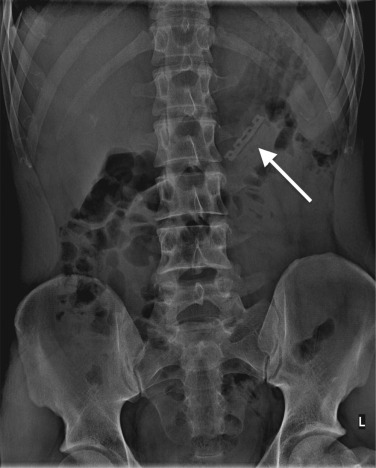
In the acute abdominal setting, plain radiography should only be considered in situations where it is likely to yield useful information, which will impact diagnosis or patient management. Plain radiography remains useful in diagnosing perforation of a viscus and for assessing bowel dilatation (the main valid indications; Table 18.1 ). Plain AXR is not helpful in diagnosing common inflammatory conditions of the abdomen such as acute appendicitis, diverticulitis, cholecystitis and pancreatitis. For this reason, plain radiography should be avoided in these situations. Clinical assessment, US, CT and, in selected settings, MRI should replace AXR for investigation of these inflammatory conditions.
|
For the acute abdomen, a supine AXR and an erect chest radiograph (CXR) can be regarded as the basic standard radiographs. The erect CXR is invaluable in diagnosing visceral perforation. For this investigation, the patient should ideally remain in the erect position for 10 minutes before radiography to allow time for any free gas to rise to the highest point, although this may not be feasible in busy clinical practice. The AXR should ideally be taken with an empty bladder and should include the area from the diaphragm to the hernial orifices, which, in practice, means that the obturator foramina should be included. Other projections including the erect AXR, historically done to assess the number and length of air-fluid levels within the small or large bowel, have fallen out of favour because evidence shows that they can be misleading and unreliable for this. Occasionally, a left lateral decubitus radiograph may be performed, specifically to detect small amounts of intraperitoneal free air, which will be described later in this chapter.
When reviewing a plain AXR, it is important to be able to attribute all the gas to normal anatomical structures, namely viscera. There are numerous causes for gas in abnormal places; the most frequent is pneumoperitoneum but other causes include gas in the retroperitoneum, gall bladder, biliary tree, liver, kidneys, urinary bladder and within abscesses.
The presence of free intra-abdominal gas almost always indicates perforation of a viscus: for instance a perforated peptic ulcer. Other causes of perforation include obstruction, inflammatory conditions, bowel ischaemia and injury during colonoscopy. Approximately 70% of perforated peptic ulcers will demonstrate free gas, a phenomenon rarely seen in the case of perforated appendicitis. Small amounts of gas are detectable under the right hemidiaphragm on an erect CXR, outlining the smooth surface of the liver clearly ( Fig. 18.2 ), but on the left it can be difficult to distinguish free gas from stomach and colonic gas. The diaphragm is seen as a relatively thin structure outlined by free gas below and lung above. The free gas under the right and left hemidiaphragms may join across the midline (cupola sign). There are many circumstances when interpretation of an erect CXR is difficult. Table 18.2 lists the most frequent situations in which perforation may be wrongly suggested or diagnosed (pseudo-pneumoperitoneum) ( Fig. 18.3 ). A lateral decubitus radiograph can resolve the problem by demonstrating gas between the liver and the abdominal wall, but nowadays CT is usually requested when there is doubt. As interpretation of the plain AXR can be unreliable, it is important to consider clinical findings during interpretation of the plain AXR.
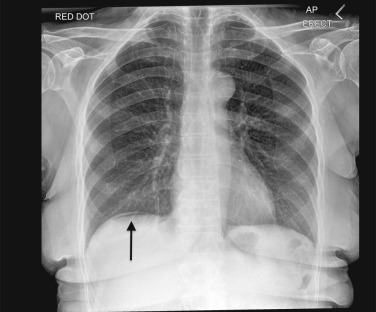
|
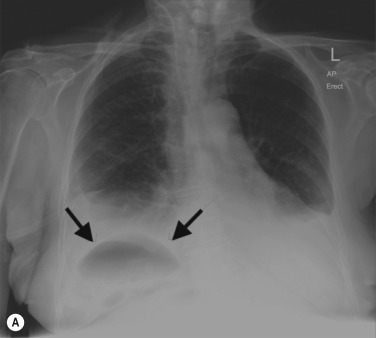
It is also important to be able to recognise the signs of pneumoperitoneum on supine AXRs: for example, in patients being monitored for colitis. In many patients, particularly those who are unconscious, have suffered trauma, are old or critically ill or taking steroids, perforation may be clinically silent as it is overshadowed by other serious medical or surgical problems. In approximately half of patients with pneumoperitoneum, gas may be detectable on the supine radiograph with free air in the right upper quadrant adjacent to the liver, lying mainly in the subhepatic space and the hepatorenal fossa (Morrison's pouch). Visualisation of both sides of the bowel wall (outer and inner) is known as Rigler's sign ( Fig. 18.4 ), which can be difficult to appreciate if several loops of bowel lie close together. Pneumoperitoneum may also be detected on AXR, when the falciform or medial umbilical ligaments are outlined by free gas lying on either side ( Fig. 18.5 ) or when air is seen in the fissure for the ligamentum teres. The signs are listed in Table 18.3 .
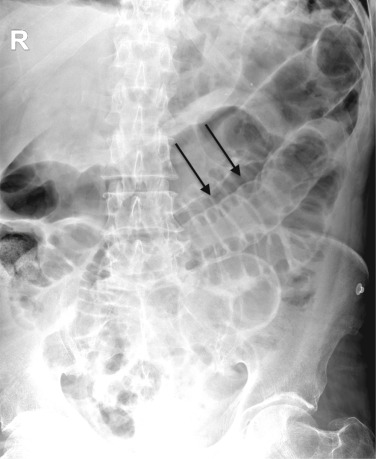
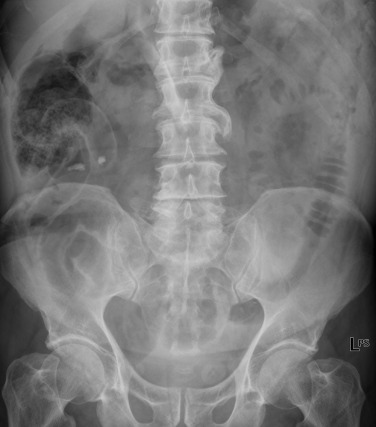
|
CT is the most sensitive investigation for the detection of free peritoneal gas. Small volumes of free gas can be seen over the liver and anteriorly in the central abdomen or in the peritoneal recesses. To not miss small amounts of free gas, the images should be reviewed on broad window settings (e.g. lung windows) ( Fig. 18.6 ).
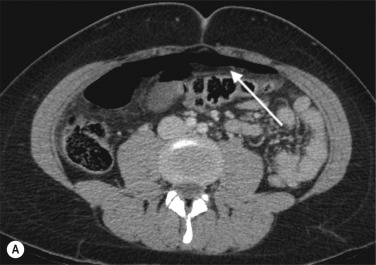
There are a number of causes of pneumoperitoneum without peritonitis, which are listed in Table 18.4 .
|
If linear gas streaks are seen in the bowel wall ( Fig. 18.7A ), intestinal infarction should be suspected. Intestinal infarction is a grave condition caused by thrombosis or embolism of the mesenteric vessels such as the superior mesenteric artery. Other radiological signs are non-specific, consisting of slightly dilated loops of small bowel that may be gas filled, or poorly seen when mainly fluid filled. The walls of the small-bowel loops may be thickened due to submucosal haemorrhage and oedema (see Fig. 18.7B ). Pneumoperitoneum may be present if perforation has occurred. Intraluminal gas in the mesenteric veins or portal vein may be seen in advanced cases. These features can be readily demonstrated on CT.
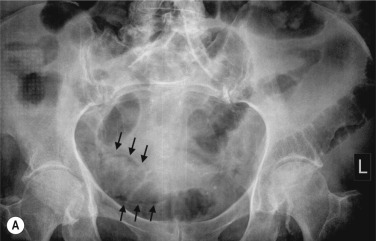
Pneumatosis cystoides intestinalis is an uncommon condition consisting of benign cyst-like collections of gas in the walls of hollow viscera. The aetiology is unknown, but there is an association with obstructive airways disease. The left hemicolon is the most common site and the term ‘pneumatosis coli’ is used to describe it. Most patients are past middle age; symptoms include vague abdominal pain, diarrhoea, constipation and mucus discharge. The cysts vary in size from 1 to 3 cm and lie both in the subserosa and submucosa. Intermittently and subclinically, these cysts rupture, producing a pneumoperitoneum without evidence of peritonitis . It is important to recognise pneumatosis as the cause of the pneumoperitoneum in such cases so as to avoid an unnecessary laparotomy . One should also be aware of circumstances where intramural gas may be incorrectly suspected (pseudo-pneumatosis)—such as air trapped between mucosal folds or between bowel wall and luminal content—to prevent unnecessary intervention. As with most findings in abdominal imaging, the finding of intramural air or portal venous gas must be correlated with the patient's condition, findings on clinical examination and on laboratory investigations (e.g. serum lactate, C-reactive protein levels or white cell count) before any major management decision is made.
Gas can escape into the retroperitoneum and the causes of this include perforation of a posterior peptic ulcer, perforated sigmoid diverticular disease, colonoscopy and other iatrogenic causes. The gas may be best visible in the flanks or around the kidneys ( Fig. 18.8 ). Retroperitoneal gas can track superiorly into the mediastinum and inferiorly into the buttock and thigh. Gas in the soft tissues of the left thigh is a classical site for gas from a diverticular perforation.
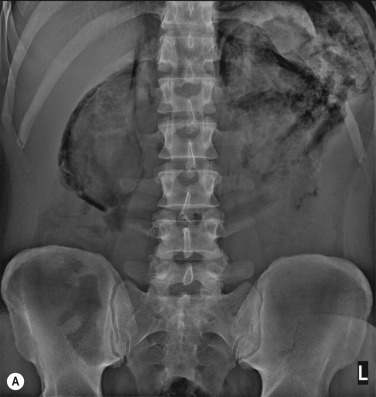
Gas may also be identified in the biliary tract, portal veins, renal collecting systems (emphysematous pyelonephritis, Fig. 18.9 ), pancreas (infected necrosis or abscess), gall bladder wall and urinary bladder.
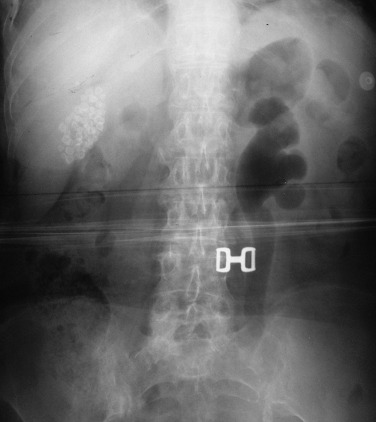
Dilatation of the bowel occurs in mechanical intestinal obstruction, paralytic ileus and air swallowing. The radiological differentiation of these different causes depends mainly on the size and distribution of the loops of the bowel and clinical correlation is essential.
Gastric dilatation may be caused by many conditions. Mechanical gastric obstruction may be benign, malignant or from extrinsic compression. It often leads to a huge fluid-filled stomach that retains its gastriform shape with little or no bowel gas beyond. This compares with the normal small gastric air bubble, usually just enough for the stomach to be identified on AXR. Paralytic ileus (often referred to as acute gastric dilatation) occurs mostly in elderly people, usually associated with considerable fluid and electrolyte disturbance.
Gastric volvulus is relatively rare and may result from twisting of the organ around its longitudinal or mesenteric axis. There is usually a collapsed small bowel and virtually no gas is seen beyond the stomach. The stomach loses its gastriform shape and becomes spherical ( Fig. 18.10 ). If oral contrast medium is given, there may be complete obstruction in the lower oesophagus, or if contrast medium does enter the stomach, it may not pass beyond the obstructed pylorus.
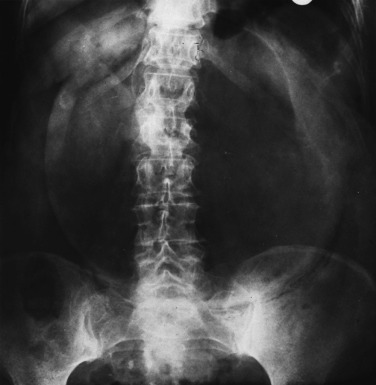
When a radiograph shows dilated bowel, it is important to determine whether it is small or large bowel, or both. Useful differentiating features include the size and distribution of the loops. Dilated small-bowel loops are usually more numerous and arranged centrally in the abdomen. The loops show a small radius of curvature and rarely exceed 5 cm in diameter. The small-bowel folds (valvulae conniventes) form thin, frequent, complete bands across the bowel gas shadow, prominent in the jejunum but becoming less marked in the ileum. The valvulae conniventes are much closer together than colonic haustra and become thinner when stretched ( Fig. 18.11A ). If the small-bowel blood supply is compromised, however, and the bowel becomes oedematous or gangrenous, the valvulae conniventes may become thickened.
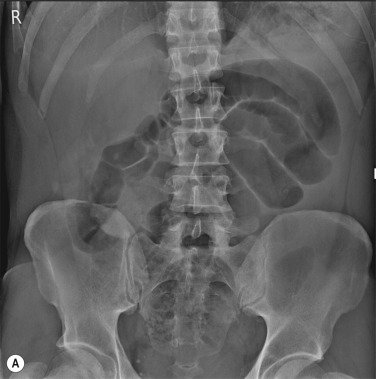
It may be difficult to distinguish the distal ileum from the sigmoid colon as both may be smooth in outline and occupy a similar position, low in the central abdomen. Although haustra usually form thick incomplete bands across the colonic gas shadow, they sometimes form complete transverse bands depending on the orientation of the loop. Haustra may be absent from the descending and sigmoid colon but can usually still be identified in other parts of the colon, even when it is massively distended ( Fig. 18.11B ).
Differentiation between small- and large-bowel dilatation on plain abdominal radiograph:
Small bowel: central position, calibre > 3.5 cm < 5 cm, presence of valvulae conniventes
Large bowel: peripheral position, >5 cm, presence of haustra
Become a Clinical Tree membership for Full access and enjoy Unlimited articles
If you are a member. Log in here